Early Childhood Standards of Quality for ... - State of Michigan
Early Childhood Standards of Quality for ... - State of Michigan
Early Childhood Standards of Quality for ... - State of Michigan
Create successful ePaper yourself
Turn your PDF publications into a flip-book with our unique Google optimized e-Paper software.
ELE: early Learning in maTHEMATICSExamples <strong>of</strong> Experiences and Strategies• Children are given the opportunity to solve math problems that occur inthe daily life <strong>of</strong> the classroom; e.g., “How many are at school today?”“How many are absent?”• Children are allowed time to solve problems and to talk through theirideas and solutions with others.• The classroom library contains books that show positive examples <strong>of</strong>problem solving.• Children have access to many books with numbers as part <strong>of</strong> the storiesor those that encourage them to count and play with counting words.• Both boys and girls have the opportunity to solve challenging problems.• When possible, key words from the classroom’s primary and secondarylanguages are used or learned; e.g., problem/problema.• Manipulatives are available <strong>for</strong> children that are increasingly challengingto solve.• Children learn a sequence <strong>of</strong> steps <strong>for</strong> problem solving.• Children are encouraged to use the language <strong>of</strong> mathematics andhave access to materials that can be named (e.g., geometric shapes,measuring tools, quantities <strong>of</strong> objects they have counted) and describedmathematically; e.g., describing the positions <strong>of</strong> people or objects;comparing the sizes and shapes <strong>of</strong> unit blocks; talking about events intime such as be<strong>for</strong>e, after, today, yesterday, be<strong>for</strong>e my last birthday.• Adults use problem solving vocabulary in their conversations withchildren; e.g., predict, change, observe.• Adults use children’s knowledge <strong>of</strong> prior experiences when problem solving.• Adults draw attention to new situations and problem solving opportunitiesin the daily working <strong>of</strong> the classroom.• Adults model the process <strong>of</strong> solving every day problems; e.g., asking“Let’s decide what to do; How many children want to go on a walk?”• Teachers respond with positive dialog and encouragement as childreninitially try to solve problems.• Adults ask open-ended questions and listen to the children’s responses.• Teachers model problem solving both inside and outside the classroom.• Teachers and families know that children are developing the ability tosolve math problems and talk with them as they experience correct andincorrect responses.• Families realize that problem solving can be a positive experience and notalways a crisis.• The classroom routine allows <strong>for</strong> unhurried time <strong>for</strong> trial and error whensolving a problem.<strong>Early</strong> <strong>Childhood</strong> <strong>Standards</strong> <strong>of</strong> <strong>Quality</strong> <strong>for</strong> Prekindergarten 109


